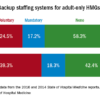Prevalence of pulmonary embolism among syncope patients
Clinical question: What is the prevalence of acute pulmonary emboli (PE) in patients admitted for syncope?
Background: An acute pulmonary embolism is a differential consideration among patients admitted with syncope. However, current guidelines do not guide evaluation.
Study design: Cross-sectional study.
Setting: Two academic and nine non-academic hospitals in Italy.
Synopsis: Five hundred-sixty patients admitted with a first episode of syncope were evaluated for a PE. Patients with atrial fibrillation, treatment with anticoagulation, recurrent syncope, or who were pregnant were excluded. The simplified Wells score was used to stratify patients into low and high-risk groups, while low-risk groups received D-dimer testing; 230 patients had a positive D-dimer or a high-risk Wells score and received either CT pulmonary angiography or VQ scans.
Ninety-seven of the 230 patients were found to have a PE (42.2%), leading to a prevalence of 17.3% among the entire cohort. The study did not include the 1,867 patients who were discharged from the ED without admission, potentially leading to bias and overestimating the prevalence of pulmonary emboli (PE).
Bottom line: The prevalence of PE in patients with syncope is higher than previously thought, highlighting the importance of considering acute PE in patients hospitalized with syncope.
Citation: Prandoni P, Lensing AWA, Prins MH, et al. Prevalence of pulmonary embolism among patients hospitalized for syncope. N Engl J Med. 2016;375(16):1524-31.
Dr. Marr is a clinical instructor at the University of Utah School of Medicine and an academic hospitalist at the University of Utah Hospital.







